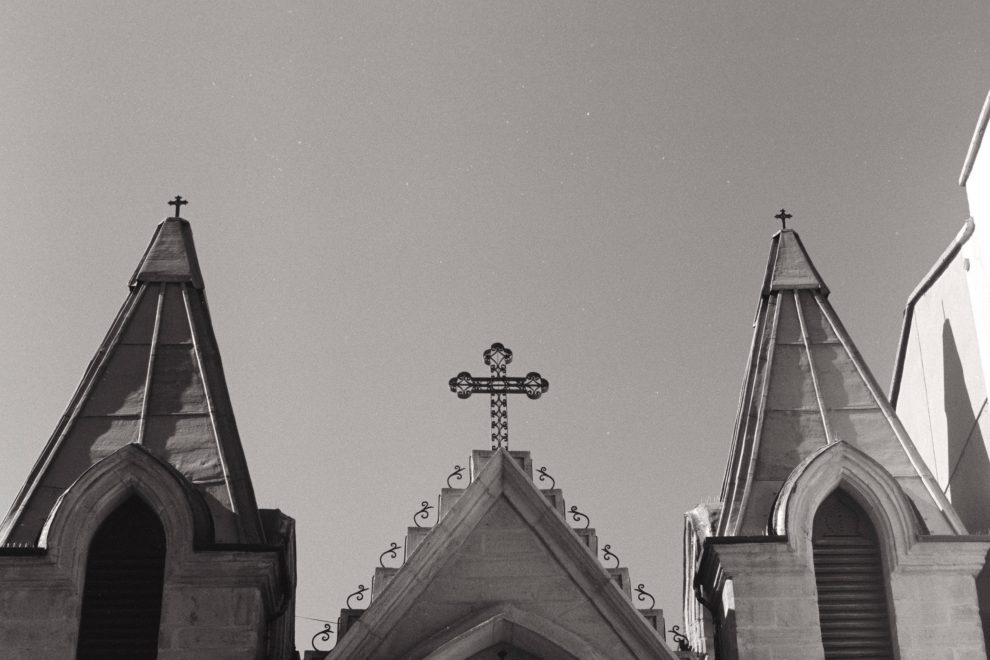The day after their farewell Mass, parishioners of St. Frances Xavier Cabrini Church were locked out. Archdiocesan officials had changed the locks days ahead of schedule.
So they walked around the building in Scituate, Massachusetts, desperately pulling on door handles. And then, one of the doors opened. Ever since, parishioners have kept vigil, staying in the church 24 hours a day, seven days a week, in protest of the closure. That was six years ago.
The parishioners of St. Frances, along with eight other closed parishes, appealed their case to the Vatican. The Vatican ruling came down this summer, and, perhaps not surprisingly, it backed the Boston archdiocese’s right to close the parishes.
Boston, still recovering from the sexual abuse crisis, is ground zero for parish closings. From January 2004 to September 2005, the archdiocese closed or merged 62 parishes as part of a reconfiguration process.
“The seeds of the financial crisis are rooted in the sexual abuse crisis,” insists Jon Rogers, a “vigiler” at St. Frances. In 2002 the Boston archdiocese faced hundreds of accusations of sexual abuse, most of which were settled for $86 million. The consequences of the abuse crisis left the archdiocese in a shaky financial state.
But St. Frances Cabrini was solid. Built in 1960, the parish boasted 3,000 families. While many parishes in Boston had declining numbers, suburban parishes like St. Frances were holding strong.
“We not only took care of ourselves,” Rogers says, “but we built and supported churches in India.”
“In Boston, the problem had a lot to do with financing. It wasn’t strictly about the abuse crisis–although you can’t speak about [parish closures] without that coming into it,” explains Jesuit Father William Clark, assistant professor of religious studies at the College of the Holy Cross in Worcester, Massachusetts. “It’s something they would have had to address, even without the abuse crisis. The finances were at a critical point.”
This isn’t just Boston’s problem. A growing number of parishes across the United States are facing closures and mergers. It’s a trend that will continue into the future, according to Jesuit Father Thomas Sweetser, director of the Milwaukee-based Parish Evaluation Project. And while finances are a major impetus for the closures, he says the shortage of priests is the No. 1 reason.
The number of priests in the United States has plummeted from nearly 60,000 in 1965 to nearly 50,000 in 1995 to just more than 40,000 in 2009, according to the Center for Applied Research in the Apostolate (CARA) at Georgetown University. Meanwhile, the number of Catholics continues to increase–from 45.6 million in 1965 to 57.4 million in 1995 to 65.2 million in 2009. That’s one priest for every 1,630 Catholics today, compared with one for 778 Catholics in 1965. But the reality of such numbers do not make the process any easier.
“It’s common now, especially in areas where churches are being closed, to say the church is not a building. The church is the community,” explains Clark. “That’s certainly the case. But in Catholicism we’ve been conscious of the roles sacred spaces have to enhance people’s faith.”
Catholics cross themselves whenever they pass a church building. They dip their fingers in holy water when they enter one. “There are all these indicators of reverence. There’s something very wise in the tradition about that,” says Clark. “We don’t intend to communicate that there’s a way that God is more present inside a church building. But the way we treat it focuses people’s attention in such a way that the building becomes a sort of a landmark of the presence of God.”
The harsh reality, given the state of priestly vocations and the economy, is that the question isn’t how to stop parish closures but how to do these closures well.
Parish Marriage
It didn’t take long for Father Mark J. Krylowicz to discover there were some financial problems with Holy Rosary Church in Chicago. After being appointed the pastor in 2005, he got his first electric bill.
“As soon as I sat down and started looking at the checkbook, I realized they hadn’t budgeted enough,” he says. “The people didn’t realize how bad a situation they were in.” But with a new pastor in charge they found out. He tried different things to make the parish viable-establishing an endowment, a heavy evangelization effort, an increase in tithing–but it all came up short. Parishioners were giving beyond their means, and the parish had to be closed.
His efforts to save the church, however, did have an upside: He won the parishioners’ trust. So when the parish faced a merger, Krylowicz–who was also pastor of St. Anthony of Padua down the street–had the “church cred” to bring his flock along. Most of the 100 English-speaking parishioners voted to join him at St. Anthony, a predominantly Hispanic parish, rather than attend another relatively close parish.
“We had the right priest at the right place at the right time,” says Tod Fraund, who had been on the Holy Rosary finance council. “We saw the effort, we saw that he was trying to make it work. It was his commitment to us.”
Still, parish leaders estimate they lost around 20 percent of parishioners. In a small congregation, losing these members hurt almost as much as closing the church, says Mary Ann Kopchak, who was “born and raised” at Holy Rosary.
“I saw the plan, I was part of the plan. That was the building, but it was the people who are the church, it was the people who built my faith.”
Getting the majority of the congregation to buy into a parish merger isn’t easy. Krylowicz, for example, was open about the financial realities the community faced, and the community tried to deal with it as a parish family. When it didn’t work, he let parishioners vote on what parish they would merge with. Some might call it empowerment; others might call it ownership. But Holy Rosary parishioners, dealing with the hard reality of closing their parish, at least had some say.
“You can close the church with the little ‘c,’ but not the church with the big ‘C,’ ” says Kopchak, who now heads up liturgy planning at St. Anthony. She and others at Holy Rosary made a commitment to each other and to the St. Anthony community when their church closed two years ago. Dubbed “a commitment ceremony,” it was part of their closing Mass. The day before, they had a jazz concert–which they called their bachelor party–and afterward they had their “move-in day.” They thought of the merger as a marriage.
So parishioners loaded up all their stuff–candles and statues and chalices-and processed over to St. Anthony. They were met along the way by matachines, traditional Mexican dancers, and when they arrived, “their new family” welcomed them with applause.
In the back of St. Anthony is a backlit stained glass window of the Blessed Mother giving the rosary to Saint Dominic. The window, and the altar before it, are from Holy Rosary. It symbolizes the closed church, but it also recognizes that the Holy Rosary community is not really gone. It just moved.
“You really have to work at having these rituals of closure,” says Sweetser of the Parish Evaluation Project, using the analogy of a funeral rather than a wedding. “It’s not an easy thing. It’s kind of death and dying. What we’re trying to say is that there’s a resurrection. It’s because those two parish cultures are different that it’s hard to bring them together.”
Loss and renewal
Paying attention to these details and having closing ceremonies and rituals helps mergers. It validates parishioners’ loss and gives due reverence to the sacred places that are being closed. Father David Noone had that in mind when he oversaw the merger of Our Lady of Mercy and St. Francis de Sales in Loudonville, New York.
Like Father Krylowicz in Chicago, he oversaw the two merging communities. And he also left many decisions up to the parishioners. Faced with having to close one of their two churches, parishioners eventually decided to keep St. Francis, a larger church with more expansive grounds.
On Thanksgiving, Our Lady of Mercy parishioners processed a mile to St. Francis. The altar from Our Lady of Mercy had replaced the altar at St. Francis. The cross of the risen Christ had also been switched out. And while the original St. Francis baptismal font was kept, some water from Our Lady of Mercy was poured into it.
“It’s the old Abe Lincoln thing: ‘You’re not going to please all the people all the time.’ But most of the people, I think, were satisfied,” says Ed Prince, who’d been a parishioner at St. Francis for decades.
The community decided both parishes would close and a new parish-Christ Our Light-would be established at the St. Francis site. Picking the name, Prince says, was one of the most difficult parts. More than 200 suggestions were submitted. They were narrowed down, and eventually the community voted for the new name at Sunday Masses.
“The idea is that both churches lose their identity. The feeling is that it’s a renewal. There’s also a sense of loss of both parishes,” Prince says.
“To make the new people feel-I say ‘the new people,’ I mean the people who are moving into this new church,” he says, catching himself. “It’s a big, big change for the people who have been in the church for years and years. They had their kids baptized and their parents buried there. They lost a lot.”
And the community lost a lot of parishioners, according to Bill Mielke, an active member in both Our Lady of Mercy and Christ Our Light. “There are many people who are absolutely heartbroken that the church closed, and I expect it’s going to take two generations until the dust settles on this,” he says.
That’s despite a lot of consultation.
Sweetser and Franciscan Sister Peg Bishop of the Parish Evaluation Project came in and interviewed at least 70 parishioners from both churches after a survey asking for parishioner input had been sent out.
But in the end the merger itself wasn’t a choice. It was preordained. Despite the financial viability of both Our Lady of Mercy and St. Francis, one of the two churches would have to close. There simply weren’t enough priests to cover both parishes.
So what about a parish life coordinator? Parishioners at Our Lady of Mercy asked the same question. “That wasn’t what the diocese had in mind. So that angered quite a few people and that started the exodus,” Mielke says.
How many left? Mielke can’t be sure, but from a parish community of 1,200, maybe 200. People at St. Francis weren’t all happy, either. Some had a mindset that things would stay the same, so when the communities actually merged, it was a bit of a “jolt,” as Mielke describes it.
Priest alternatives
Suggesting alternatives such as parish life coordinators is fairly common among parishes threatened with closure or merging. And for some, the shortage of priests has fueled discussion about ordination of married and women Catholics.
“We don’t believe the priest shortage is a valid reason to close parishes,” says Sister Chris Schenk, C.S.J., of FutureChurch, a national network of parish-based activists. “We’re closing parishes rather than opening ordination. Why couldn’t we open the conversation to the married priesthood?”
Resisting parishes in Boston formed the Council of Parishes, which works to prevent church closures. They also suggest parish life coordinators or lay or religious administrators to circumvent closures.
The Cleveland diocese faced a diminishing number of priests, and 46 percent of parishes finished in the red in 2006, according to Robert Tayek, spokesperson for the diocese.
Not only that, but with the faithful moving away from Cleveland and into the suburbs, two thirds of the parishes were serving one third of Catholics. It just didn’t make sense to have so many parishes open in the city when the majority of Catholics no longer lived there.
The diocese announced closings and mergers in March 2009, and parishes had 15 days to appeal. Many did. Three of those appeals–by St. Colman, St. Ignatius of Antioch, and St. Stephen-resulted in changes. These three parishes were given a four-year directive to prove their viability. But in the vast majority of appeal cases, Bishop Richard Lennon’s original decision was upheld. St. Peter Church, which held its closing Mass on Easter Sunday, was one of them.
Some embittered parishioners boycotted the final Mass with the bishop and soon formed a “breakaway” congregation, even renting their own building. Lennon threatened excommunication.
According to the Code of Canon Law, a diocesan bishop can entrust the pastoral care of a parish to a layperson so long as a priest directs that pastoral care. Parish life coordinators run about 4 percent of parishes in the United States, but such appointments appear to be less popular in recent years. There seems to be reluctance on the bishops’ part.
“I get the sense that we’ve gone from a ‘family-owned business’ to a ‘corporation model.’ And the people feel that,” says Clark at the College of the Holy Cross. “There was always an overarching sense of being part of a worldwide community. But that coexisted with a feeling of being rooted in a community that you were a part of and you were responsible for. Where that existed, in many places it has been lost.”
Vox populi
Making that sense of community a priority is part and parcel of the more successful parish closures. Where parishioners resist closures, as in the case of the Boston vigil churches, Catholics often feel a lack of consultation and a stripping of ownership.
In the early 1990s, the Archdiocese of Chicago closed around 30 parishes because of a “financial emergency.” Lay participation was not a priority, but they learned their lesson, according to Jean Welter, who’s headed up research and planning for the archdiocese for the past 10 years.
“With the parishes we’ve closed, we’ve always tried to encourage as much lay participation as possible,” she says. “That way everyone has some voice in what the outcome might look like.”
But in the end bishops are charged with making sure the difficult decision is made. The mission of the church, its service to those in need, cannot take a backseat to the preservation of a church building.
“If you have no income, how do you educate the children? How do you provide social services?” Welter says. “If you cannot address those needs, if your money is just keeping a bell tower from crashing in on people, it’s not really being what a parish should be.”
Whatever the consultation, whatever the lay involvement, painful decisions must be made to serve the mission of the church. When lay Catholics make those decisions themselves, the process runs more smoothly. But the decisions must be made, one way or another, and it’s never easy.
This article appeared in the October 2010 issue of U.S. Catholic (Vol. 75, No. 10, pages 12-17).
Image: Ahmet Çiftçi from Pexels














Add comment